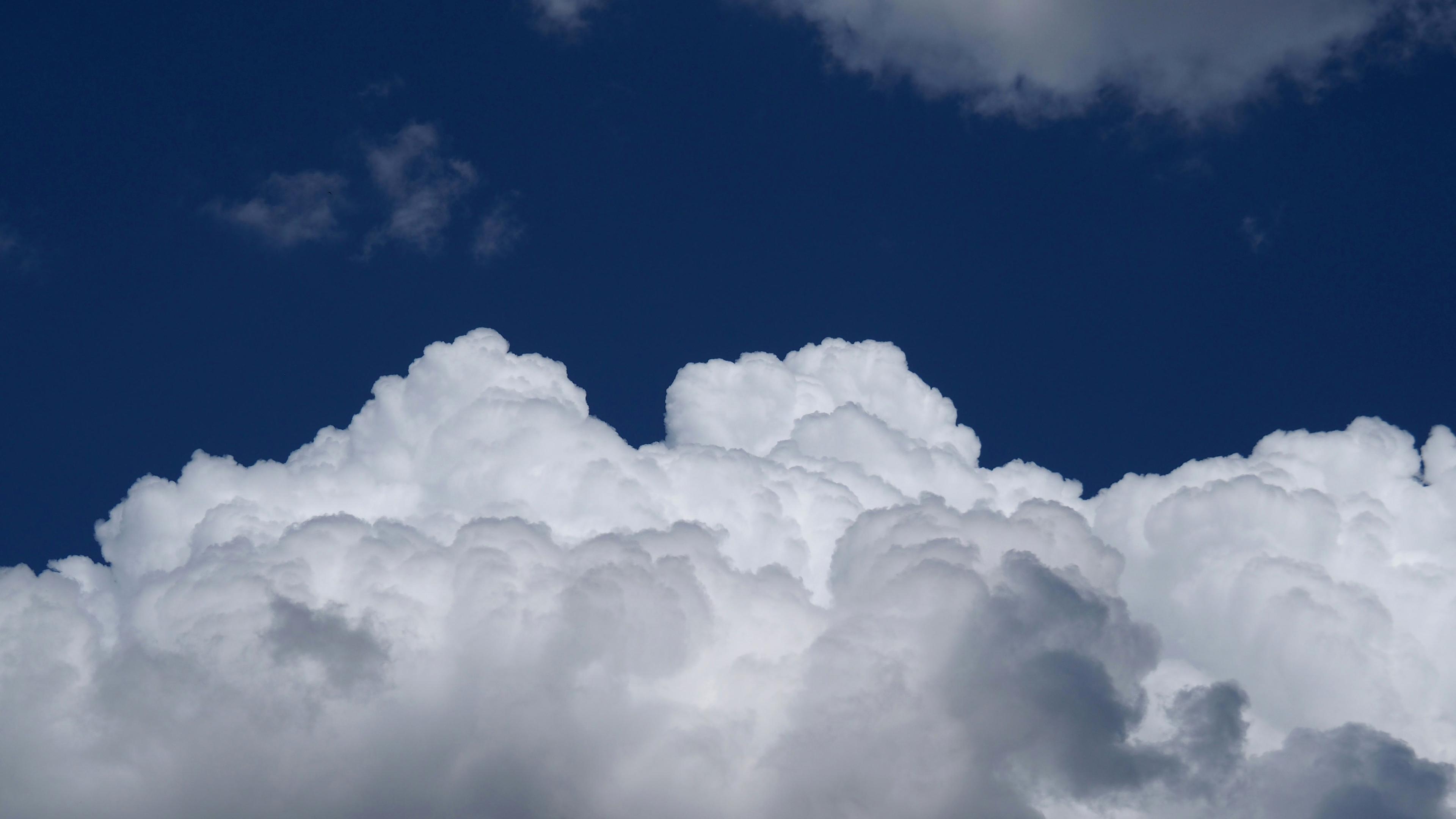Keeling Curve Lessons
Lessons for long-term earth observations
Charles David Keeling directed a program to measure the concentrations of CO2 in the atmosphere that continued without interruption from the late 1950's through the present. This program, operated out of Scripps Institution of Oceanography, is responsible for the Mauna Loa record, which is almost certainly the best-known icon illustrating the impact of humanity on the planet as a whole. Lessons can be learned about making long-term measurements based on the experiences of this program.
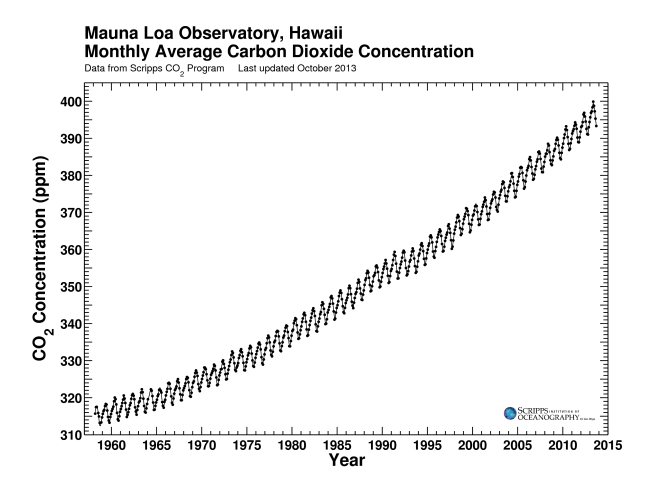
The idea of making measurements at Mauna Loa arose while Charles David Keeling was a post-doc at Cal Tech. In the course of working on a project involving carbon in river water - a project that incidentally required making measurements of CO2 in air - Charles David Keeling made a key discovery. What he discovered was that when he sampled the air remote from forests, cities, and other obvious sources or sinks for CO2, he always got almost the same value of 310 ppm. Previous measurements of CO2 in the atmosphere did not show such constancy, but these measurements had been made by wet chemical methods that were considerably less accurate than the dry manometric method he was employing. This postdoctoral experience taught him two key lessons that were to guide his entire career: (1) that the earth system might behave with surprising regularity, and (2) the necessity of making highly accurate measurements to reveal that regularity.
With the discovery of this stable background, it immediately became of interest to ask how stable this background might be. Discussions ensued with Harry Wexler of the US Weather Bureau, the precursor agency of NOAA, and Wexler suggested that CO2 measurements be made on a continuing basis at the newly created station on Mauna Loa. Rather than joining Wexler in Washington D.C., Charles David Keeling instead accepted an offer to come to Scripps Institution of Oceanography where Roger Revelle was interested in spinning up a CO2 measurements program. Roger had a somewhat different idea of how the measurements should proceed, and believed the right approach was to make large surveys of the atmosphere and ocean at, say, decadal intervals. By maintaining strong contacts with Wexler at the Weather Bureau, Charles David Keeling was ultimately able to set up measurements at Mauna Loa even while being at Scripps Institution of Oceanography.
The value of the Mauna Loa record soon became readily apparent. Within just a year or two, Charles David Keeling had shown that CO2 underwent a regular seasonal cycle, reflecting the seasonal growth and decay of land plants in the northern hemisphere, as well as a regular long-term rise driven by the burning of fossil-fuels.
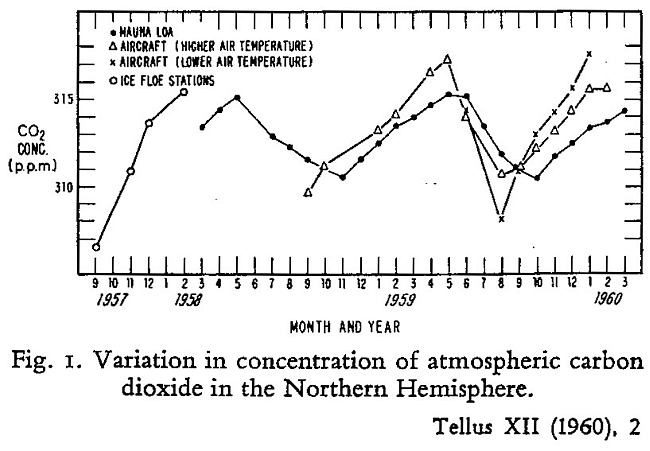
By the early 1970's this curve was getting serious attention, and played a key role in launching a research program into the effect of rising CO2 on climate. Since then, the rise has been relentless and shows a remarkably constant relationship with fossil-fuel burning, and can be well accounted for based on the simple premise that 57% of fossil-fuel emissions remain airborne. Here the number 57% was selected to fit the curve at the ends of the record, but what is significant is how well this link with fossil-fuel burning also fits the curvature in the record, sloping upwards less rapidly at the beginning, and more rapidly at the end.

The Mauna Loa record can now be placed in the context of the variations in CO2 over the past 400,000 years, based on reconstructions from polar ice cores. During ice ages, the CO2 levels were around 200 ppm, and during the warmer interglacial periods, the levels were around 280 ppm. The levels in 2005 were around 378 ppm.
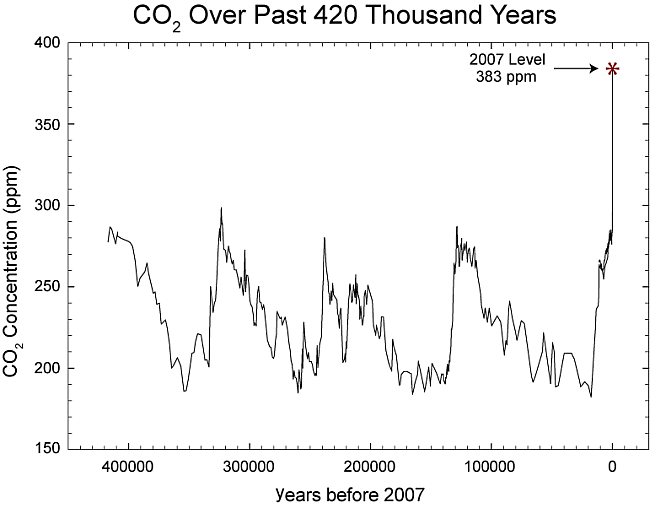
Looking ahead, if the rate of fossil-fuel burning continues to rise on a business-as-usual trajectory, such that humanity exhausts the reserves over the next few centuries, CO2 will continue to rise to levels of order 1500 ppm. The atmosphere will not return to pre-industrial levels even tens of thousands of years into the future. Unless serious efforts are made to reduce the dependence on fossil fuels, it is clear that we are on a threshold of a new era of geologic history, one with climate very different from that of our ancestors. These curves not only demonstrate the seriousness of the global warming problem, but also illustrate the power of continuous time series to communicate and clarify the essential science.
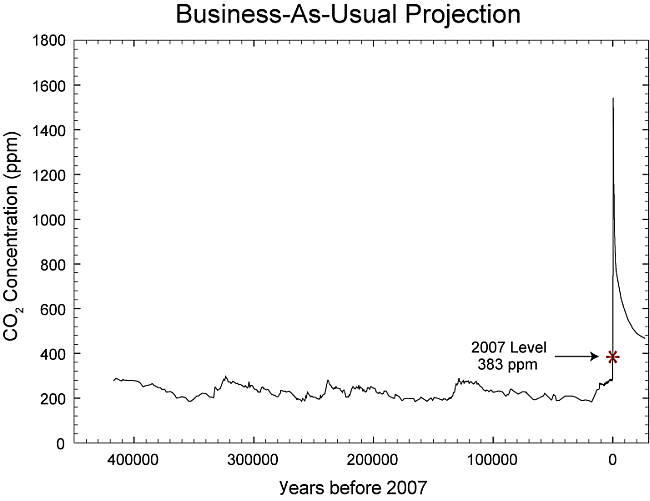
Another way to illustrate the power of continuous time series is to address the "what if" question of where we'd stand if the measurements were only intermittent, say based on field campaigns every decade or two. The curve loses its simple message as well as raising questions of quality and integrity. Are the points after 1980 really more consistent than the points before 1980? Could the rise simply be a random fluctuation? These questions, which seem legitimate in the context of a sparse record, don't even come to mind in the context of the complete record, with its relentless rise.
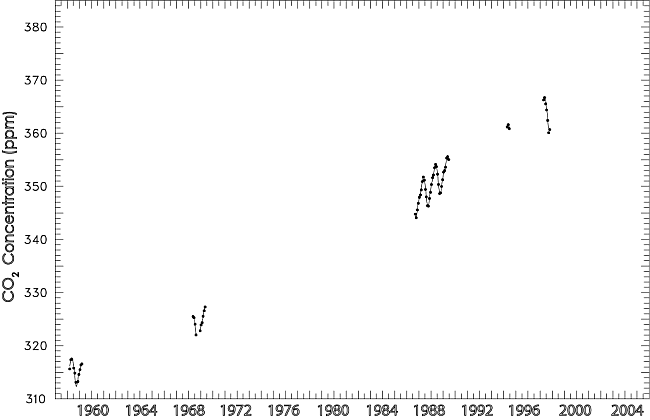
But while the rise may seem unstoppable, there was nothing inevitable about obtaining the record itself. The Scripps Institution of Oceanography program was actually shut down for a period in 1964 following congressionally mandated budget cuts, and would have been discontinued at that time had Charles David Keeling not pushed hard to keep it going. The program had to endure a series of threats through the 1970's and 1980's associated with a coordinated effort by program officers at NSF and NOAA to transfer full responsibility for global CO2 observations to NOAA. The program was rescued by DOE, but was never on a very secure footing and was subject to occasionally bizarre requirements, such as a "mandated convergence" with NOAA and a requirement that new discoveries be made based on the records at a pace of 2 per year.
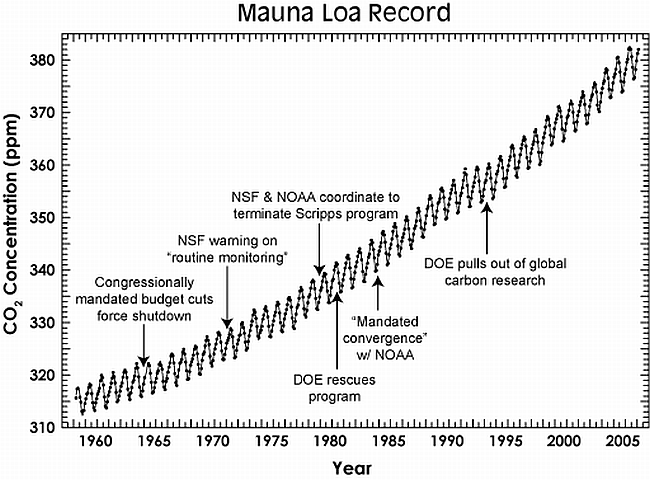
Over the last decade, the Scripps Institution of Oceanography program has coexisted peacefully alongside a much larger effort by NOAA. Having two programs is arguably very important for long-term continuity. As Charles David Keeling states: "There was no guarantee that NOAA’s program might not have problems in the future. The CO2 measurements, he argued, were important enough that at one spot on the Earth, two parallel sets of measurements were justified."
From Charles David Keeling's perspective, the desire to continue the Scripps Institution of Oceanography program was motivated by his desire to expand his understanding of the earth. Using the Scripps Institution of Oceanography record, he continued to publish ground breaking papers through the 1980s and 1990s, including a study showing that a larger than expected sink for CO2 existed in the extra-tropical northern hemisphere, and a study showing that the growing season had lengthened in the northern hemisphere (Keeling et. al. 1995 Nature Vol. 375 and Keeling et. al. 1996 Nature Vol. 382). Having access to and a deep understanding of the longest records was a key factor in these discoveries.
What lessons can be drawn from Charles David Keeling's experiences
(1) Many observations, now considered vital to the study of the earth and being carried out over a long time frame, were begun in a university setting. The Mauna Loa record is probably the most outstanding example of this. Another example is the Hubbard Brook Ecosystem study, an early prototype for a long-term ecological research site.
(2) A university setting does have advantages for this kind of work, by providing a home for improvements of technology, the training of students, and advancing and disseminating the science. In the case of the Scripps Institution of Oceanography CO2 program, specific advantages can be cited. With its modest scope, the program can afford to maintain an emphasis on producing the highest quality long-term time series, as well as to allow for continued technological improvements that advance the state of the art in the measurement of atmospheric CO2 and related tracers. The program also provides key linkages between atmospheric and oceanic carbon measurements, between observations and models, and provides the world a center for training experts.
(3) The shifting priorities of federal agencies is also a serious challenge to any long-term measurement program. This problem is not, however, necessarily any more serious in a university setting than in a government agency. In fact, the flexibility to draw support from many directions allowed in a university setting actually helps buffer against short-term policy changes.
(4) Better coordination between federal agencies doesn't necessarily improve the environment for supporting university programs. For example, the most serious threat to Charles David Keeling's program came in the early 1980's — a period when NSF, NOAA, and DOE worked together to consolidate all CO2 measurements under NOAA's control.
(5) The normal peer review system of handling proposals is not necessarily incompatible with sustaining a long-term measurement program in a university setting. In the case of Charles David Keeling's program, securing favorable reviews did not prove as challenging as maintaining a funding stream in the face of the shifting priorities and doctrines of the agencies.
Our understanding of how the earth had changed and is changing draw heavily on a small number of variables that have been measured very carefully over long periods of time. These time series are the cornerstone of our understanding and provide the icons with which to communicate that understanding to the wider public. As we contemplate a future in which measurements can be made with much higher density based on deploying sensors in situ and using space-based platforms, one might easily imagine that the earth science of the future will take a rather different form. This will only be the case if these expanded efforts can also be sustained at high quality over long periods of time. That remains to be seen.
